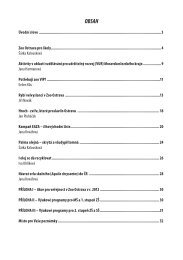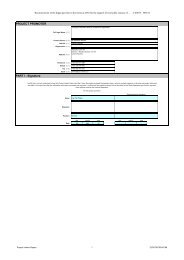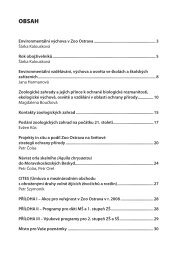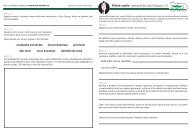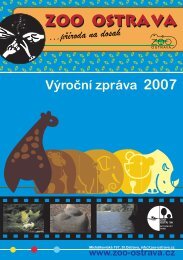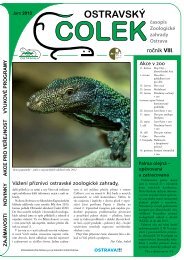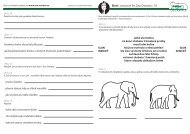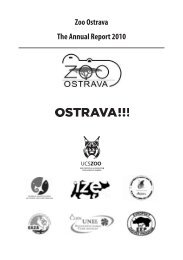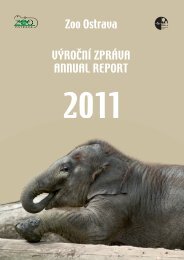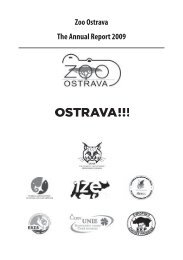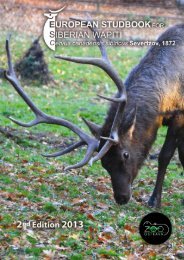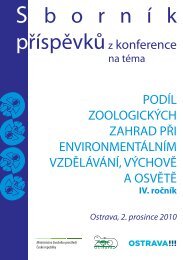48Rearing the cinereous vulture at <strong>Ostrava</strong> <strong>Zoo</strong>Renáta HalfarováThe cinereous vulture (Aegypius monachus) resides in the mountain ranges of Asia, more rarely thoseof Europe, up to 4,000 metres above sea level. This vulture is listed as Near Threatened under the IUCN Red Listof Threatened Species. The fact that the reared bird could be released into the wild in the French Alps, thusreinforcing the restoring wild population in Europe is seen as the most important contribution.In the most recent period, <strong>Ostrava</strong> <strong>Zoo</strong> has kept cinereous vultures since 2002, with however setting upa breeding pair being the issue in the beginning. This was made with success in 2006, when the zoo obtaineda young pair as an exchange for an adult female within the breeding cooperation, i.e. European conservationbreeding programme - EEP. The birds had been successfully put together in Planckendael. Soon after theimport, the birds could be seen getting along very well. The male originates from Arnhem <strong>Zoo</strong>, where hehatched on 19 May 2003, while the female hatched in Mulhouse on 10 May 2002. The birds were directlyplaced in a shared aviary sized 11.9 by 6.9 m, with the minimum and maximum height of 2.8 m and 4 m,respectively. As the aviary is located in a common block of aviaries, it was visually separated from the othersusing a reed mat installed on its side up to the 1/3 of its height. In the rear highest part, there is a woodenplatform.During their first nesting season (2007), the birds were showing no special activities; nonetheless, they wereapparently harmonising, grooming and sitting close to each other all the time. The following season (2008),we supplied softwood and hardwood twigs of varied size, sheep, llama and camel hairs and other nestingmaterials into the aviary. The birds were first lacking any interest in this, but in early March, mating wasobserved. This time the birds started showing interest finally in the nesting matter as well, which howevertook a few days and the nesting activity ended as of mid March. The aviary was checked, with found twigscollected on the platform, but the nest remained unfinished.Considering the fact that the birds had reached maturity, the <strong>2009</strong> nesting season was the one with firstserious attempts at nesting expected. Therefore, nothing was left to fortune and the base of the nest wasbuilt by the staff, still retaining the opportunity of finishing by birds. The nest base consisted of birch twigsarranged on the wooden platform so that they were forming the nest, with conifer twigs added on the topto make the nest soft. The very top was covered with sheep wool. Nesting materials were thrown around thenest as well. In late January, the diet was enriched with a higher rate of live food and 1 ml of PROMOTOR perbird plus PLASTIN added.At the end of February, both birds became interested in the materials supplied and actively involved infinishing the nest, so everything looked very promising. Nonetheless, everybody was much surprised seeingthat the female sat down on the nest on 7 March <strong>2009</strong>, taking turns with the male in sitting on the eggs inthe beginning. However, seeing a keeper, the birds became too nervous, trying to lift up, so any entry wasrestrained to supplies of food and fresh water. The nest was inspected only on 26 April using only a slot in therear wooden wall of the aviary; the time was good as both birds were out of the nest. The date of clutch wasderived from the date when the female first sat on the nest, which was 7 March <strong>2009</strong>. A thin voice was heard
as the birds changed over on 28 April, this assumed to be the day of hatching, meaning that the incubationperiod lasted 53 days.Over the next days, birds were observed to move as if feeding, but as the vultures were still nervous seeinga keeper, there was no chance to look at the chick and the keeping staff was more and more anxious. At thattime, small chicken and beef meat was eliminated from the diet, with only whole rabbits and rats includinginternal parts and hair retained, fed with torn skin. Neither vitamins nor minerals were added to the diet.Within a few days, the demand for food was apparently higher! The quantity of food was regulated asnecessary.On <strong>12</strong> May, a head of the chick could be finally clearly identified using a field-glass. On the nest, there wasat least one of the parents at all times. On day 46 of the chick's life, branches were pruned pretty far from theaviaries, causing the birds significantly disturbed. As a result, both vultures spent the whole day outside thenest, refusing food over the next two days, meaning they did not feed the chick either. Once calmed down,the birds returned to their daily routine.As from 26 June, the parents kept the young bird alone on the nest, while the adults were sitting by onperches. Once feeding was finished, the little vulture 'marched' up and down the nest. This case showed verywell the importance of keeping the birds fully undisturbed throughout the nesting time. As from 16 August,the young bird was already walking all over the perch and on 17 August, which was day 1<strong>12</strong> of its life, it waseven seen to leave the perch very frequently, moving all around the aviary.Upon consultations and agreement of <strong>Ostrava</strong> <strong>Zoo</strong> personnel with EEP Coordinator, the young vulture wastransferred to France to help restore the local population, which took place on 9 September <strong>2009</strong>. All along thetravelling period, which took about 20 hours, the vulture stayed calm. Prior the transfer, blood was sampledto determine sex, and the vulture, who turned out to be a male, was microchipped. In France, the male wassubsequently ringed and placed in a pre-release aviary, where he was kept around a month to get adaptedto the new habitat.Before the definitive release, a transmitter was implanted in the young bird and its flight feathersdiscoloured. The young cinereous vulture bred at <strong>Ostrava</strong> <strong>Zoo</strong> was released into the wild in the territoryof Verdon canyon on 18 October <strong>2009</strong>, which crowned the zoo personnel efforts with success, fulfilling oneof the key objectives of modern zoological parks.49
- Page 2 and 3:
Provozovatel zoo: Zoologická zahra
- Page 5 and 6:
ObsahÚvodní slovo ředitelePetr
- Page 7 and 8:
Vážení příznivci Zoo Ostrava,d
- Page 9 and 10:
Stavy chovaných zvířatChov zví
- Page 12 and 13:
pečovaly o mláďata z roku předc
- Page 15 and 16:
2) z účelově vázaného přísp
- Page 17 and 18:
Rok 2009 byl pro naši organizaci v
- Page 19 and 20:
Výnosy v roce 2009v tis.Kč% změn
- Page 21 and 22:
Osobní náklady tj. vlastní mzdy,
- Page 23 and 24:
Výstavba, projektová činnost a
- Page 25 and 26:
Z dalších změn v areálu zoo sto
- Page 27 and 28:
• byla dokončena projektová př
- Page 29 and 30:
Vzdělávací a propagační činno
- Page 31 and 32:
• 25.7. Když si zvířata hrají
- Page 33 and 34:
Činnost dendrologického oddělen
- Page 35 and 36:
Pozorování a sběr údajů o zví
- Page 37 and 38:
Rok šelem v Zoo OstravaMonika Ondr
- Page 39 and 40:
Historický nárůst počtu chovan
- Page 41 and 42:
Chov nového druhu primáta v Zoo O
- Page 43 and 44:
akovinným bujením, které zapří
- Page 45 and 46:
Odchov supa hnědého v Zoo Ostrava
- Page 47 and 48:
Repatriace supa hnědého a orlosup
- Page 49 and 50:
ještě před vylétnutím a jejich
- Page 51 and 52:
Odchov ohrožených druhů papoušk
- Page 53 and 54:
tuto budku přijali. Opět si vytvo
- Page 55 and 56:
pobývali většinou venku, mládě
- Page 57 and 58:
Novinky u slonůPavel ZvolánekRok
- Page 59 and 60:
při průchodu porodními cestami,
- Page 61 and 62:
Róze se poslední mládě narodilo
- Page 63 and 64:
Návrat orla skalního (Aquila chry
- Page 65 and 66:
Seznam zaměstnanců Zoo Ostrava (k
- Page 67 and 68:
Jméno Funkce Počet let v org.62 P
- Page 69 and 70:
Druh (poddruh)Species (subspecies)S
- Page 71 and 72:
Druh (poddruh)Species (subspecies)S
- Page 73 and 74:
Druh (poddruh)Species (subspecies)S
- Page 75 and 76:
Druh (poddruh)Species (subspecies)S
- Page 77 and 78:
Druh (poddruh)Species (subspecies)S
- Page 79 and 80:
Druh (poddruh)Species (subspecies)S
- Page 81 and 82:
Druh (poddruh)Species (subspecies)S
- Page 83 and 84:
Druh (poddruh)Species (subspecies)S
- Page 85 and 86:
Druh (poddruh)Species (subspecies)S
- Page 87 and 88:
Druh (poddruh)Species (subspecies)S
- Page 89 and 90:
Druh (poddruh)Species (subspecies)S
- Page 91 and 92:
Druh (poddruh)Species (subspecies)M
- Page 93 and 94:
FormaFormazajícovci (Lagomorpha)St
- Page 95 and 96:
▲ Nejvzácnější přírůstek r
- Page 97 and 98:
▲ Úprava vnitřních prostor v p
- Page 99 and 100:
▲ Odběr spermatu u samce slona i
- Page 101 and 102:
◀ Nový druh v Zoo Ostrava - peli
- Page 103 and 104:
▶ Pohlednice u voliéry supů hn
- Page 105 and 106: ◀ Google v zoo při sběru datpro
- Page 108 and 109: Zoological Garden OstravaAddress: Z
- Page 111 and 112: ContentsDirector´s introductory wo
- Page 113 and 114: Dear friends,Ostrava Zoo is coming
- Page 115 and 116: Animal numbersAnimal collection in
- Page 117 and 118: of which a member of the very rare
- Page 119 and 120: success refers to the offspring pro
- Page 121 and 122: The founder’s non-capital funding
- Page 123 and 124: 3) CZK 737 thousand allocated to re
- Page 125 and 126: To co-fund 46.4% from the operating
- Page 127 and 128: As regards cost items in 2009, only
- Page 129 and 130: namely tiger enclosures, hoofed mam
- Page 131 and 132: Design, development and maintenance
- Page 133 and 134: This operation was supported by the
- Page 135 and 136: • Development of the building app
- Page 137 and 138: Ostrava Zoo - the zoo office and ma
- Page 139 and 140: Again, the event was co-funded by t
- Page 141 and 142: and involved models of a turtle she
- Page 143 and 144: Activities of the Horticulture Depa
- Page 145 and 146: and it was carried out by the scien
- Page 147 and 148: A year of carnivores at Ostrava Zoo
- Page 149 and 150: Historical increase in the number o
- Page 151 and 152: Keeping a new primate species at Os
- Page 153 and 154: for the lemurs, where the family of
- Page 155: Month 8 Beira's climbing the ropes
- Page 159 and 160: • Birds of prey are rather slow i
- Page 161 and 162: Monitoring nests of endangered bird
- Page 163 and 164: The yellow cardinal at Ostrava ZooY
- Page 165 and 166: a bowl with fresh water multiple ti
- Page 167 and 168: it was found that one egg was impre
- Page 169 and 170: eginnings when the young are fed by
- Page 171 and 172: The way the bull was handled within
- Page 173 and 174: Keeping the common hippopotamus (Hi
- Page 175 and 176: Studbook # /nameSexDate ofbirthDam/
- Page 177 and 178: General summaryThanks to the projec
- Page 179 and 180: NamePositionNumber of yearsin the o



